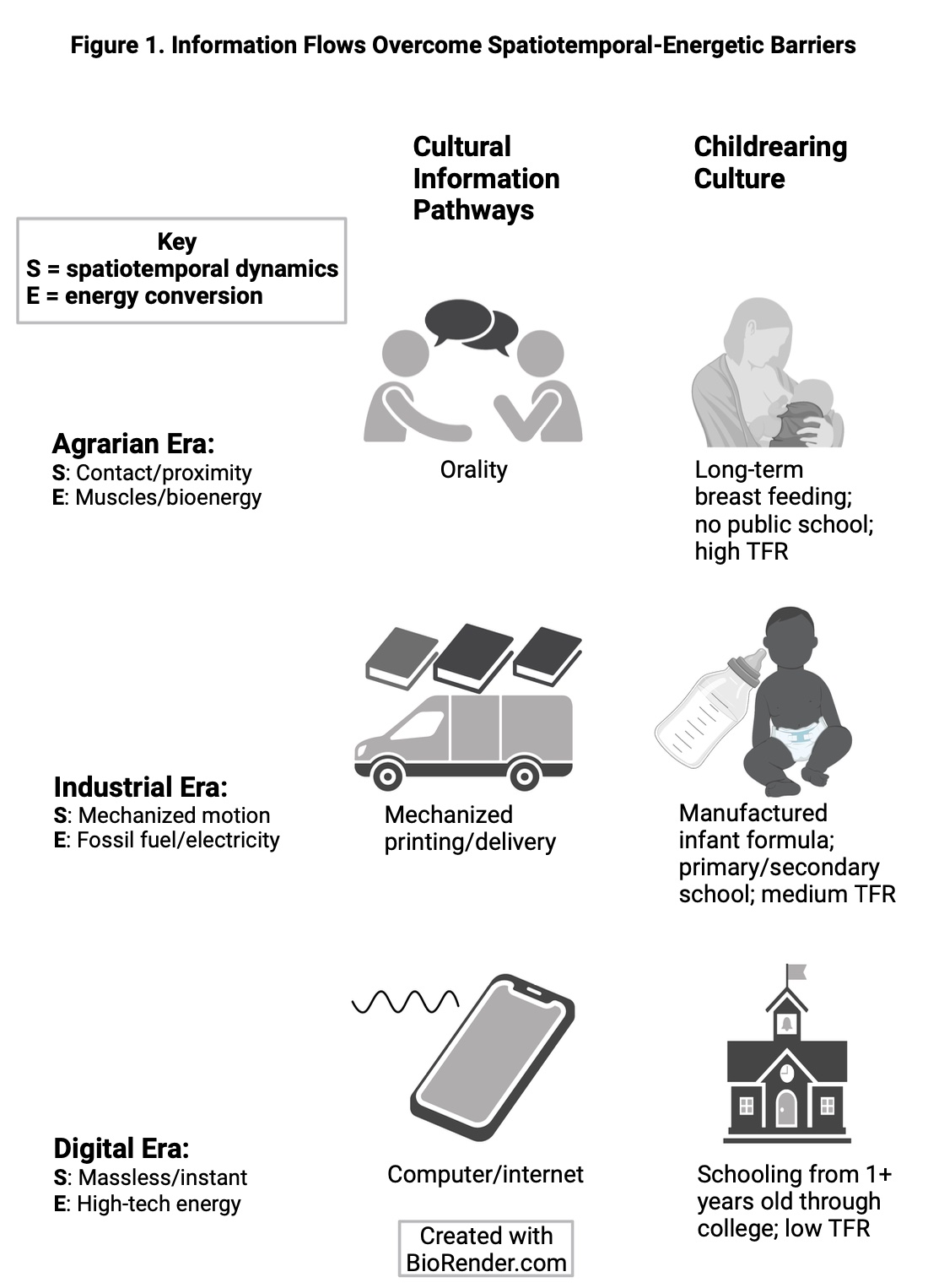Chris Girard, an Associate Professor of Sociology in Florida International University, looks at childrearing culture from the perspective of coevolving informatics
During the 20th and 21st centuries, growth in mass schooling represents a rupture with thousands of years of home-based socialization of children. The spatiotemporal dynamics of expanding children’s formal education, outside of the home, coevolve with more learning-centred culture and greater specialization in energy sources (e.g., fossil fuels, electricity). This three-way interaction between socializing information flows, space, and energy is investigated by coevolving informatics. A key insight is that greater depth in information flows overcomes spatiotemporal and energy-conversion barriers (Girard 2020).
Information-flow depth increases with the number of layers or pathways (figure 1). For most of human existence, a foundational oral information pathway has been rigidly constrained by hearing range and by human bioenergy. Given these two constraints, parents’ chances of passing on their heritage increased with the number of children reared and kept nearby within the household. This adaptive strategy remained until new information pathways emerged.
The relatively recent addition of textual and digitalized knowledge pathways has deepened information flow and shifted the spatiotemporal dynamics of childrearing. As an adaptive strategy for passing on parental heritage, bearing a large number of children is being superseded by having fewer children to maximize the quality of their formal education. In addition, spatiotemporal dynamics in childrearing become less rigidly bounded insofar as there is reduced child-parent body contact and less interactive proximity, for example, as infant formula replaces breastfeeding.
Socialization is increasingly governed by long-distance cultural information flow that is externalized outside the human mind (e.g., print media, AI). Ultimately, oral, textual, and digital-era information pathways undergo transitions within constraints imposed by agrarian, industrial, and knowledge economies respectively.

Rigid spatiotemporal boundaries of bioenergy-dependent childrearing
In agrarian societies, rigid spatiotemporal boundaries for childrearing are imposed by mother-infant proximity and bioenergy dependence. Lactating mothers keep babies on or close to their bodies, carrying children despite musculoskeletal stress. Moreover, recent data on isotope ratios found in bones reveal that breastfeeding typically lasted two to three years in Neolithic Europe. In agrarian societies, the infant’s proximity to the mother’s body is likely to have been constant and long-term.
Rigidly bounded spatiotemporal dynamics would also arise from higher rates of childbearing (fertility) in agricultural societies than in other kinds of societies. Bentley et al (1993: 779) report that foraging and horticultural societies showed average total fertility rates of 5.6 and 5.4 respectively. In contrast, for peasant societies, the estimated mean number of children per woman over a lifetime was 6.6. Consequently, childrearing would be dominated by pregnancy, lactation, and maternal-infant carrying over much of early adulthood.
Mechanization’s effects on childrearing
The transition to industrial wage labor creates an entirely new pathway for cultural information flow: printed text that is mass-produced for a literate public.
Mechanized printing and mechanized delivery of the text is enabled by distinct spatiotemporal dynamics – moving assembly lines and machine-generated motion – which coevolve with the extra somatic energetics of fossil fuels and electricity. This newly emerging pathway, comprising printed text in machine-produced books and articles, eventually fosters growth in human capital. Affordable machine-produced literature provides the foundation for mass schooling that extends from elementary schools to universities.
In addition, industrial mechanization has reduced women’s reliance on contact-intensive bioenergy for bearing children and breastfeeding. The growing affordability of water-based infant formula, developed and mass-produced in the 1920s, reduced contact intensity by reducing breastfeeding time. In addition, the industrial economy’s demand for higher levels of formal education has promoted lifestyle choices that reduce the spatiotemporal constraints imposed by fertility. In a woman’s lifetime in Europe before 1790, one woman on average gave birth to 4.5 to 6.2 children (Roser 2014). By 1950 Europe’s total fertility rate (TFR) averaged 2.7 (GCDL 2023). Over the long run, declining fertility rates reflect rising opportunity costs for staying home to care for children. These costs include forgoing both employment income and more intrinsically rewarding work that comes with higher levels of education. Overall, the mechanized economy’s demand for formal schooling has made the spatiotemporal dynamics of childrearing less rigidly bounded.
Digital-Era learning-centred childrearing
The transition to a knowledge economy is creating a distinctive pathway for cultural information flows: data streams between and within computers, rapidly updated by college-educated professionals. The spatiotemporal dynamics of these massless electromagnetic signals, travelling at light speed, coevolve with increasing specialization in high-tech energetics (e.g., ion-lithium, solar, etc.).
The growth of learning-centred culture in the post-industrial world further contributes to less rigidly bounded spatiotemporal dynamics for childrearing.
Children’s daycare and formal education become part of a lifelong learning strategy to increase human capital. In addition, learning-centred culture and associated growth in women’s education are contributing toward lowering fertility. The TFR has dropped dramatically from 2.3 (1970) to 1.5 (2021) for Europe and from 4.8 (1970) to 2.3 (2021) globally (Roser/GCDL 2022). An increasing number of women with a college degree are choosing to reduce their work-life balance constraints by having fewer children. On average in OECD countries, the majority (53.7 per cent) of women aged 25-34 are now entering the job market with a tertiary-level education (OECD 2023).
Coevolving informatics links three key processes
These key processes include increasing depth in cultural information flow, social evolution toward less rigidly bounded spatiotemporal dynamics, and greater specialization in energy conversion. Based on the coevolution of these three dynamics, childrearing has become less home-based and more learning-centred with increasing depth in cultural information flows.
- Bentley et al (1993) https://doi.org/10.1086/204223
- GCDL (2023) https://ourworldindata.org/grapher/children-per-woman?tab=table&country
- Girard (2020) https://link.springer.com/article/10.1007/s40844-019-00152-2
- OECD (2023) https://doi.org/10.1787/0b8f90e9-en
- Roser (2014)/GCDL (2022) https://ourworldindata.org/fertility-rate

This work is licensed under Creative Commons Attribution-NonCommercial-NoDerivatives 4.0 International.


